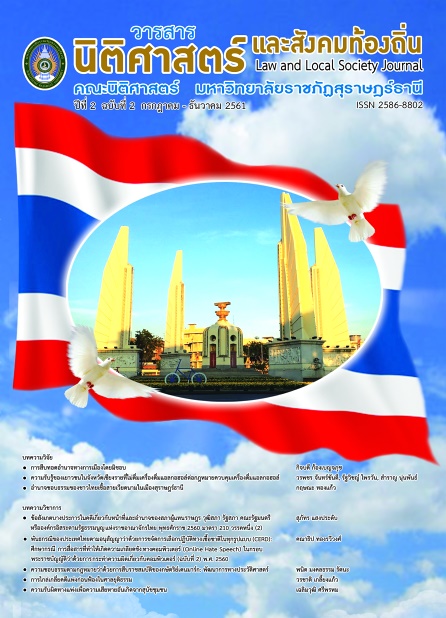ความชอบธรรมตามกฎหมายว่าด้วยการสืบราชสมบัติของพระมหากษัตริย์เดนมาร์ก: พัฒนาการทางประวัติศาสตร์
คำสำคัญ:
การสืบราชสมบัติ, กษัตริย์เดนมาร์ก, กฎหมายรัฐธรรมนูญบทคัดย่อ
แม้ว่าแนวคิดว่าด้วยการเมืองและการปกครองในประวัติศาสตร์ได้เปลี่ยนแปลงไปแต่ราชอาณาจักรเดนมาร์กสามารถธำรงสถาบันกษัตริย์เป็นประมุขยาวนานสืบเนื่องกว่าพันปี จึงควรศึกษาเหตุปัจจัยดังกล่าว คือ ความชอบธรรมทางกฎหมายว่าด้วยการสืบ ราชสมบัติของกษัตริย์เดนมาร์กเกี่ยวกับที่มาของความชอบธรรมและตราสารทาง กฎหมายอันเป็นรากฐานแห่งความมั่นคงของราชบัลลังก์ในแต่ละช่วงสมัย ดังเช่นในปัจจุบันความชอบธรรมตามกฎหมายว่าด้วยการสืบราชสมบัติของกษัตริย์เดนมาร์กเป็นไปตามกฎหมายลายลักษณ์อักษรตามพระราชบัญญัติอันเป็นส่วนหนึ่งของรัฐธรรมนูญ หากจะแก้ไขเปลี่ยนแปลงต้องกระทำตามกระบวนการแก้ไขเพิ่มเติมรัฐธรรมนูญและจำต้องได้รับความเห็นชอบจากประชาชนโดยการทำประชามติ
เอกสารอ้างอิง
2. Alfred Stepan, Juan J. Linz and Joli F. Minoves. (2014, April). Democratic Parliamentary Monarchies. Journal of Democracy. 25(2). .com/royalty/Denmark/dk-suc-law.html. Retrieved 8 March 2018.
3. Bavornsak Uvanno. (2017). Public Laws Volume IV: States. Bangkok: Winyuchon.
4. Caitlin Christine Maya Larson. (2012). Viking Social Structure and Gender Roles in Scandinavia Based on Burials and Grave Good, Bachelor of Science Thesis in the Archaeological Studies Program Department of Sociology an Archaeology University of Wisconsin-La Crosse. p.2.
5. Caitlin Christine Maya Larson, (2012), Viking Social Structure and Gender Roles in Scandinavia based on Burials and Grave Goods, Bachelor of Science the Faculty of The Archaeological Studies Program University of Wisconsin-La Crosse, p.3.
6. Chuck Penfold, (2009), Denmark votes to change royal succession rules [Online]. Available from: https://www.dw-world.de/dw/article/0,,4310654,00.html. Retrieved 3 August 2018.
7. David Kirby. (2013). Northern Europe in the Early Modern Period: The Baltic World 1492-1772. New York: Routledge.
Ehn, Pelle. (2016). Participation in Design Things [online]. Available from: https://pdfs.semanticscholar.org/07e4/ebf0f4ffe36b95a1f5e35c8d43a9d2dadf40.pdf Retrieved 3 August 2018.
8. Ekman, Ernst. (1957). The Danish Royal Law of 1665. The Journal of Modern History. 29 (2).
Paul Douglas Lockhart. (2007). Denmark 1513-1660: The Rise and Decline of a Renaissance Monarchy. New York: Oxford University.
9. Lars Bo Kaspersen. (2004, March). How Denmark Became Democratic: The Impact of Warfare and Military Reforms.
Acta Sociologica. 45 (1).
10. Peter Kurrild-Klitgaard. (1999). Conditional Consent, Dynastic Rights and the Danish Law of Succession [Online]. Available from: https://www. hoelseth
11. Preedee Kasemsupt. (2017). Legal Philosophy. Bangkok: Thammasart University.
12. Phokin Polkul and Chanchai Sawaengsak. (2014). Introduction to Principles of Public Law. 8thedition. Bangkok: Nititham.
13. Sompob Hotrakit. (1969). Constitutional Laws: Lecture for Bachelor Class Volume I. Bangkok: Namsia Printing.
14. The Danish Royal Law. 1665.
15. The Royal Ordinance settling the Succession to the Crown on Prince Christian of Glücksburg. 1853
16. The Act of Succession of March 27th. 1953
17. The Act of Succession of March 27th. 1953 Amended on June 12th. 2009.
18. The Constitutional Act of Denmark of June 5th. 1849.
19. The Constitutional Act of Denmark of June 5th. 1953.
20. Visanu Kreaungam. (1987). Constitutional Law. 3rd edition. Bangkok: Nitibannakarn.
ดาวน์โหลด
เผยแพร่แล้ว
รูปแบบการอ้างอิง
ฉบับ
ประเภทบทความ
สัญญาอนุญาต
บทความที่ได้รับการตีพิมพ์ในวารสารนิติศาสตร์และสังคมท้องถิ่น คณะนิติศาสตร์ มหาวิทยาลัยราชภัฏสุราษฎร์ธานี ถือเป็นลิขสิทธิ์ของวารสาร ทั้งนี้ ข้อมูล เนื้อหา และข้อคิดเห็นที่ปรากฏในบทความเป็นความรับผิดชอบของผู้เขียนแต่เพียงผู้เดียว กองบรรณาธิการไม่มีความจำเป็นต้องเห็นด้วยหรือร่วมรับผิดชอบใด ๆ
เนื้อหา ข้อมูล รูปภาพ และองค์ประกอบอื่น ๆ ที่ได้รับการตีพิมพ์ในวารสารฯ อยู่ภายใต้ลิขสิทธิ์ของวารสารนิติศาสตร์และสังคมท้องถิ่น การนำไปเผยแพร่ ดัดแปลง หรือใช้ประโยชน์ในลักษณะใด ๆ ไม่ว่าเป็นบางส่วนหรือทั้งหมด ต้องได้รับอนุญาตเป็นลายลักษณ์อักษรจากวารสารก่อน


